Identical twins form when a single zygote (fertilized egg) splits into two, creating a natural clone. There is no sure answer as to why monozygotic twinning occurs, but there are a number of scientific theories. What causes identical twins? Why does the fertilized egg split?
Like all wonderful outstanding questions, there are plenty of scientists trying to figure it out. These guys are busy studying the exact moment the egg begins to split to form twins. They are considering environmental factors, and unusual occurrences of repeat identical twins. This article is a thorough look at monozygotic twinning and what causes it:
- How Monozygotic (Identical) Twins Form
- Different Types of Identical Twins
- The Embryo Splitting Process
- Unusual Twinning Events Being Studied
- Scientific Theories for Why the Fertilized Egg Splits

What Causes Indentical Twins?
This article shares a number of scientific theories as to what causes a fertilized egg to split and create monozygotic twins. But before the theories, let’s a quick fact check on what we do know. The mechanics of what happens after the zygote starts to split.
How Monozygotic (Identical) Twins Form
Unlike fraternal twins (which come from the fertilization of two eggs), identical twins are formed when a single zygote splits into two. This natural cloning process will happen at some point in the first ten days after fertilization. The exact moment the embryos split varies, creating different ‘types’ of identical twins.
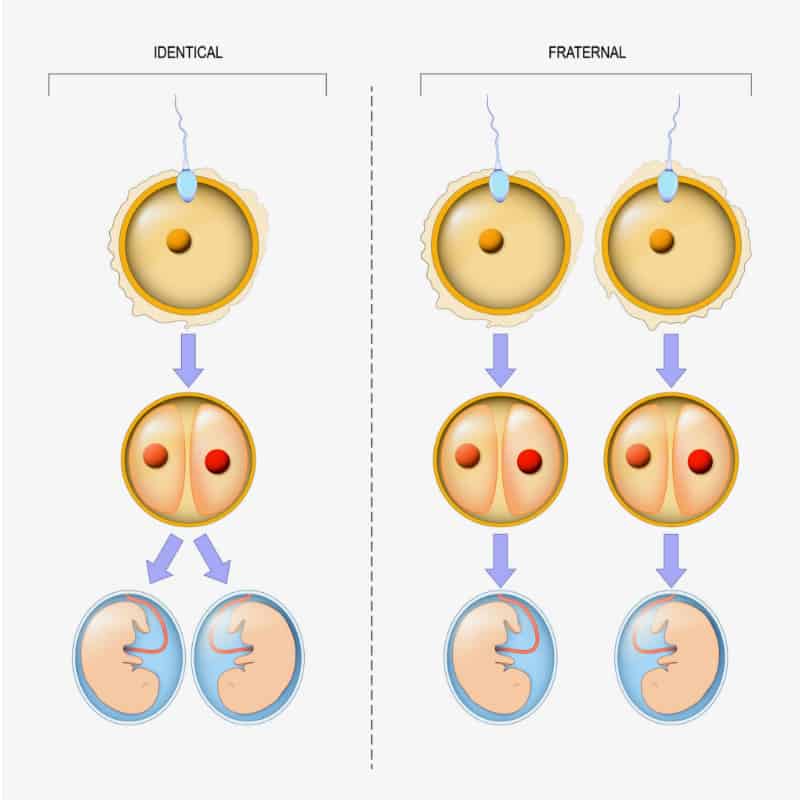
Different Types of Identical Twins:
Dichorionic/Diamniotic (Di/Di) Identical Twins
If the fertilized egg splits early, in day 1 after fertilization, the twins will form separate placentas and amniotic sacs. This type of identical twins are medically called Dichorionic/Diamniotic (di/di) twins.
A routine ultrasound will not be able to identify these twins as identical, because just like fraternal twins, they each have their own placenta. It is believed that one third of identical twins are Di/Di twins and they are often misdiagnosed as fraternal twins by doctors. Only a zygosity DNA test can confirm these twins as identical.
Just to make your head spin, it is also possible for two placentas to fuse together, usually in the second trimester. This means, fraternal twins can also be wrongly identified as identical twins, especially if a first trimester ultrasound is not performed.

Monochorionic-Diamniotic (Mono/Di or Mo/Di) Identical Twins
Most commonly, the egg will split around 4-5 days after fertilization. In this scenario, the identical twins have time to form separate sacs but will end up sharing a placenta. These, the most common type of identical twins are called Monochorionic-Diamniotic (mono/di) twins.
Monochorionic-Monoamniotic (Mono/Mono or Mo/Mo) Twins
1% of the time, the egg splits around day 9-10 after fertilization. This means the babies will share a sac and a placenta. Monochorionic-Monoamniotic twins are sometimes ‘mirror twins‘, causing quirks such as first teeth cropping up on opposite sides of the mouth, and in some cases, even internal organ positions are mirrored.
Interesting, Mono/Mono twins are more likely to be female. The later the zygote splits, the higher chance the babies will be born female.
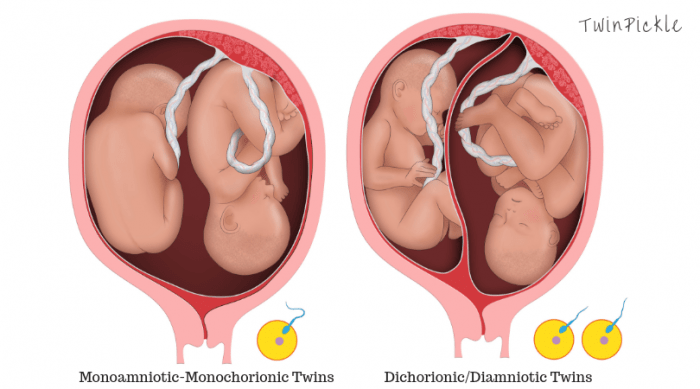
Conjoined Twins
Very rarely, the zygote splits around day 13-15, making it impossible for the twins to separate fully. This causes the babies to be born conjoined. 75% of conjoined twins are female.
As a slight curve ball, there have also been a handful of cases of ‘semi-identical twins‘, which are thought to occur due to simultaneous fertilization of the egg by two sperm.
The Embryo Splitting Process:
After a human egg is fertilized, the zygote ‘collapses’ and expands a number of times as the cells multiply. It’s during one of these ‘collapses’ that the magic moment happens. During a collapse, the cells contained in the embryo divide into two groups, allowing two separate embryos to ‘hatch’ from the protective outer layer of what is now called the blastocyst. These two matching balls of cells keep dividing and multiplying to create two separate, yet identical, babies.
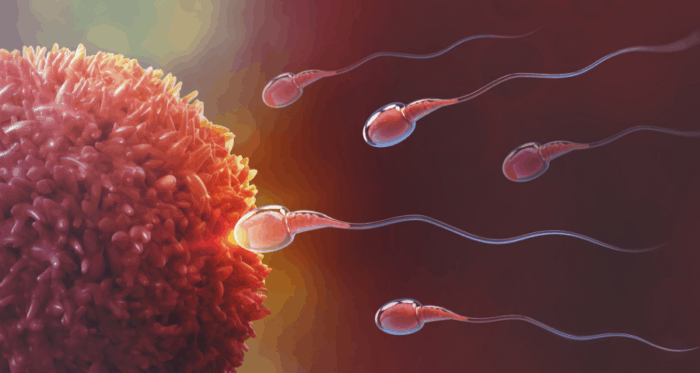
Unusual Twinning Events Being Studied
‘Twin Towns’
The Village of Umri, Allahabad, in North-East India is just one of a number of ‘twin towns’. For the past 40years, Allahabad has experienced an unusually high number of identical twin births. Locals believe the local water or soil could be the cause, because they claim animals such as buffalo are also affected by the phenomenon.
Umri, with a population of fewer than 900, stands out for a unique biological phenomenon: it has had, by local accounts, 35-40 pairs of identical twins in the past few decades.
Ahmad, S. Village Of Twins In Uttar Pradesh. April 2019. Outlook India.
Scientists are yet to find any environmental or social oddities in Umri, and DNA from the town’s twins has not given much insight either. Most researchers have written off the theory of twin towns as no more than a statistical fluke. Another twin town, Linha São Pedro in Brazil, reported in the 1990’s that 5% of births were identical twins… that’s quite the fluke.

The Nine-Banded Armadillo
Nine-banded armadillos almost always give birth to four identical quadruplets. These quadruplets are created from one single fertilized egg that splits to form twins and then each twin splits again. Some scientists believe this to be an evolutionary result of the physical constraints imposed by the shape of the armadillo’s uterus or limited sperm.
“Polyembryony might be favored as a means of increasing the number of off- spring when sperm are limited or there are constraints on the production of eggs or embryos by females.”
Loughry et all. Polyembryony in Armadillos. 1998. Valdosta State University.
While it may be an evolutionary advantage for the Armadillo, twinning of embryos in humans is considered by scientists as more of a pregnancy fail. Twin pregnancy holds higher risks of congenital anomalies, premature birth and low birth rate. Still, the armadillo has been doing pretty well from it because they’ve been around for 50 millions years.
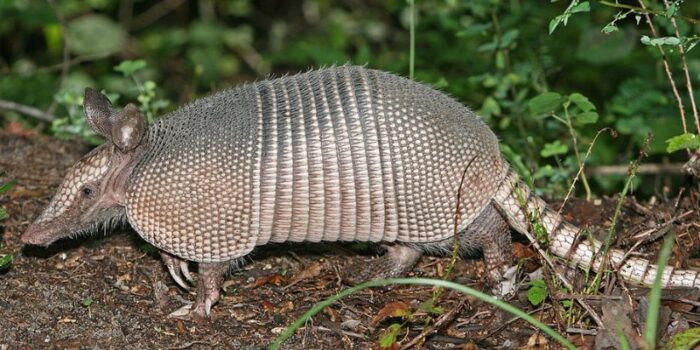
Identical Twins and IVF
When receiving IVF treatment, the chances of having identical twins rises from 0.3% to 2%. Even when only one embryo is implanted there is a 2% chance it will divide and create two identical babies.
There is no single reason why chance of embryo division is higher, but subtle differences between the lab and the human body are causing a higher rate of twinning. Some suggest the ovulation induction process may lead to a hardening of the zone pellucida (the egg coat), making it more likely to split. Some researchers believe maturing of the blastocyst before transfer causes the split.
Either way, IVF can trigger a spontaneous twinning event, and often cases of IVF triplets are those where only two embryos were implanted. One embryo splits, the other doesn’t, creating an identical pair and a fraternal twin to go with.
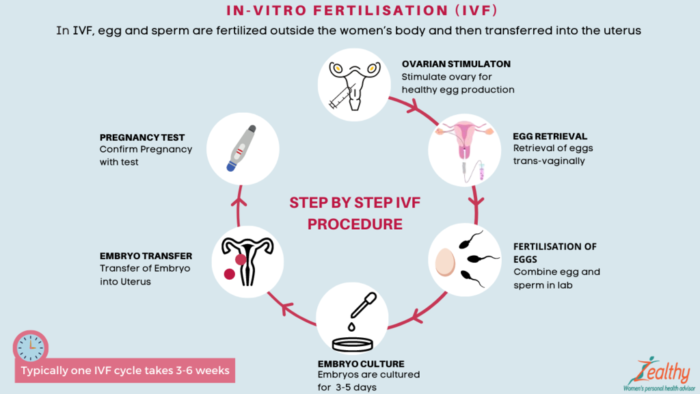
https://zealthy.in/en, CC BY-SA 4.0, via Wikimedia Commons
Scientific Theories for Why the Fertilized Egg Splits to form Identical Twins
We’ve looked at when it happens, but what scientific theories are out there for why identical twins develop from one fertilised egg?
Previously, it was thought that MZ twinning was some sort of embryological fluke. However, familial monozygotic twinning is more common than suggested by the literature.
Machin, G. 2009. Non-identical monozygotic twins, intermediate twin types, zygosity testing, and the non-random nature of monozygotic twinning: a review.
Do Inherited Gene Mutations Cause Monozygotic Twinning?
Dr Bruno Reversade is one scientist who has been busy investigating variations in the genomes of families from ’twin towns’. Although monozygotic (identical) twinning doesn’t seem to vary by geography or ethnicity, there are small pockets of increased twinning activity. These ‘twin towns’ are relatively isolated with a small breeding pool, allowing the mystery ‘twinning gene’ to be passed on in abundance.
It seems that the genes belong to the ELA (equine lymphocyte antigen) gene system may tell us something about how can run in families.
Segal, N. Twin Mythconceptions: False Beliefs, Fables, and Facts about Twins. 2017.
Dr Reversade has a candidate region, on chromosome four, and he thinks mutations in a gene here might have been present in the founders of twin towns before spreading through the population. He speculates that the mutated gene might prevent cells sticking together tightly within the blastocyst, resulting in a split.
Dr Dianna Payne thinks the imperfect environment of the IVF lab is causing some cells to die or weaken at the cell junctions. This leads to the idea that a similar process could be caused in naturally conceived embryos. A mutated gene could cause weakened cells in a collapsing blastocyst (ball of cells formed as the fertilized egg grows), triggering a twinning event. It is also possible that subtle differences in the cells could force cells to repel one another, pushing two separated groups of cells to opposite sides of the blastocyst.
Does an Enzyme in Sperm Cause Identical Twins?
There is a popular theory (although I have struggled to find any scientific sources) that an enzyme in sperm causes the embryo to split. Many families with twins claim they have an abnormal number of identical twins in their family tree, despite being told it’s a random event. Twin dads like to consider themselves carriers of super sperm… maybe they’re right?

Does X-Chromosome Inactivation Trigger Monozygotic Twinning?
Before female embryos implant into the uterus, one of the two X-chromomosones inside every cell (except the egg cells) is randomly and permanently inactivated. Which X-chromosone is inactivated is mostly random, but studies of some women have shown skewed x-inactivation. This means the same X-Chromosome in nearly all cells is deactivated, suggesting some kind of defected or mutated gene event.
It has been suggested by many that skewed X-Chromosome inactivation could cause monozygotic (MZ) twinning, explaining why Mono/Mono twins are more likely to be female.
X-inactivation does not explain all female monozygote twinning, but could be responsible for the excess of MZ female twins.
Hamamy, H. Monozygotic Twinning.
X-inactivation does not happen to male identical twins, so its definitely not the only cause of identical twinning. This does of course bring to light that there is likely multiple different causes for identical twins.
Are Early Genetic Errors Causing MZ Twinning?
Dr Judith hall claims that monozygotic twinning happens as a natural reaction to genetic errors. The growing embryo ‘senses’ a genetic error in one or some of the newly formed cells, and pushes them away from the embryo. This normally works perfectly, and the repelled cells are absorbed and no longer multiply. But occasionally the discarded cells make a break for independence, overcome genetic errors, and becomes an identical (yet not so identical) twin.
My hypothesis is that all (monozygotic) twins are not identical,” Hall said during a symposium here at the Jackson Laboratory. “Something led to the two separate embryos developing. So we’re looking for signs of discordance,” genetic differences, “and they are everywhere.”
Cooke, R. 1992. Could Early Genetic Errors Cause Twins? LA Times.
Although it is usually said that identical twins have the same DNA, there are very slight differences which can be detected by modern DNA testing. These are caused by genetic mutations and environmental factors, including conditions inside the uterus.
Does the Timing of Conception Cause Identical Twins?
Dr Judith Hall also suggests twinning depends on the timing of fertilization. This would explain why humans produce twins more often than other animals (except the armadillo of course!). Most mammals choose to mate when conditions are perfect, when eggs have been freshly ovulated. Humans on the other hand tend to have sexual intercourse randomly throughout the cycle, meaning there is more chance an older egg will be fertilized.
A fertilized egg that is not in it’s ‘prime’ moment in the cycle may be more likely to have copy errors during growth. Therefore it follows that an egg fertilized later in the cycle is more likely to have early genetic errors causing a twinning event.

Conclusion: What Causes Identical Twins?
The scientific theories are here for you to come to your own conclusion. Personally I feel very convinced by Judith Halls explanation of early genetic errors. the body has built-in responses to prevent faulty data being copied. And while most of these ‘pushed aside’ cells never become another baby, occasionally us identical twin moms are blessed with a not-so-faulty second child.
You have to remember that most identical twin embryos just don’t make it. In fact it has been suggested that least 50% of twin pregnancy become singleton pregnancies during the first trimester, usually before the first sonogram even identifies twins.
It’s a strong theory to suggest monozygotic twinning is a natural process to remove faulty cells. Luckily for me, those faulty cells gave me another son. A beautiful copy of his brother, but to me unique in every way.
Related Twin Pickle Posts:
- Do Identical Twins Have the Same DNA?
- Can Twins Feel Each Others Pain?
- Do Twins Skip a Generation?
- Does Drinking Milk Increase Your Chances of Twins?
- What are Semi-Identical Twins?
Identical Twinning FAQs
Identical twins form when a single zygote (fertilized egg) splits into two. This natural cloning process results in two genetically identical embryos.
The fertilized egg splits in the first 10 days of gestation to create monozygotic twins. Rare late splitting (13-14 days after fertilization) of the blastocyst can lead to conjoined twins.
Whether identical twins share a sac or/and a placenta will depends on when the fertilized egg splits. Most commonly the fertilized egg will split around 4-5 days after fertilization, creating Mo/Di twins.
No-one is certain as to why the zygote splits to form twins, but there are some scientific theories. These include ideas about gene mutations, and how long after ovulation the egg is fertilized.
References:
Cyranoski, D. (2009, April). Developmental biology: Two by two. Retrieved from: http://www.nature.com/news/2009/090415/full/458826a.html
Study: Identical Twins Caused by ‘Embryo Collapse’ (2007, July). Retrieved from: http://www.foxnews.com/story/2007/07/05/study-identical-twins-caused-by-embryo-collapse.html
The extraordinary moment one baby becomes two (2007, July). Retrieved from: http://www.dailymail.co.uk/sciencetech/article-465788/The-extraordinary-moment-baby-two.html
Hamamy et al. 2012. Familial Monozygotic Twinning: Report of an Extended Multi-generation Family. Retrieved from: https://www.cambridge.org/core/journals/twin-research-and-human-genetics/
Cook, R. 1992. Could Early Genetic Errors Cause Twins? LA Times. Retrieved from: https://www.latimes.com/archives/la-xpm-1992-11-01-vw-1463-story.html
Stefanescu et al. 2021. Single Fetal Demise in Twin Pregnancy—A Great Concern but Still a Favorable Outcome. https://www.ncbi.nlm.nih.gov/pmc/articles/PMC8161807/


59 responses to “Identical Twins: Why Does the Fertilized Egg Split?”
My husbands a twin, they’re identical, but mirror image, I’m not sure why that occur, but they write with different hands and have various features that are opposite. Thanks for sharing #marvmondays
ooo… he’s a mirror twin, so exciting!!! That means the split in the embryo happened quite late on, very rare indeed. I write about it a little here…
https://twinpickle.com///2016/08/31/8-things-you-may-not-know-about-identical-twins/
Thanks for dropping in 🙂
Wondering if its not genetic, if woman who have had identical twins are more prone to the eggg splitting
Iv read that more than once ?
My twin boys are identical but 1 is right handed and has a cow slick where as the other 1 is left handed without a cows slick . They took blood from the placenta and said they are 96 per cent identical
I like that there are mysteries that science still has yet to solve.
Exactly! Wouldn’t it all feel a bit pointless if we didn’t have anything left to investigate?!
That’s called a miracle… Scientists always like to have an explanation for things unexplainable to their interlect.
The scientific theories are so much fun to explore but I have to agree… sometimes we just have to accept our little miracles! ❤️
My understanding of a miracle is that which happens when the natural laws are suspended. The happening of identical twins is, it seems to me, as natural as the happening of any new life. Yes, there is an event that occurs for identical twins that does not occur for singletons; it’s called the splitting of the zygote. For now, we can accept that event as a miracle; however, one day the secret of the split might be understood scientifically. But there will still remain the philosophical question: Why? Why does not the zygote always split, as a matter of nature? Why sometimes a split? Why sometimes not? I wonder if there might be a teleological explanation; in other words, might there be a purpose underlying the creation of identical twins? We might ask, what purpose do identical twins serve? I wonder.
We certainly learn a lot from identical twins in scientific study. Their biological cloned character make them perfect for experiments. I love following the story of the two astronaut brothers and what we have learned about how space affects DNA through studying them. So you could argue identical twins are here to help us work stuff out and evolve. For me… they have made me question my spirituality, because despite knowing my boys are genetically identical, there has always been something so inherently different behind the eyes. It’s beyond science.
I am responding to TWINPICKLE’s response to my comment. I really like your suggestion: “So you could argue identical twins are here to help us work stuff out and evolve.” Yes, as if identical twins are a portal into the workings of evolution. Someone observed that identical twins have the same brain. If we see the brain as the organ of the mind, then by comparing the content of the brains of identical twins (their personalities?) we might have a direct view into the mystery of the mind, of life itself. As you say, there’s something “so inherently different behind the eyes. [of identical twins]. It’s beyond science.” What I’m thinking is that just as how by our having two eyes, each one set a bit different from the other, we can see three dimensions, so by having two sets of eyes linked to the same brain, we might be able to see into another dimension of life.
Sounds like a sci-fi movie I want to watch! I love the idea of twins being a link to another dimension. However, there is no doubt my boys have two very separate brains… one loves bananas, the other doesn’t like them. One is obsessed with marbles, the other not fussed. Why these differences? It’s all so very interesting!
I vote for magic, or miracle, or mystery. I’m like Heather, mysteries yet to be solved! That keeps us humble and identical twins a marvel.
I really enjoyed learning from your essay. I like the way you gave titles and examples. So very interesting!
A marvel indeed! Thanks for dropping by 🙂
An interesting read. In my family, every alternated generation has a twin. SO it looks like its sort of genetic. My granfathers grandfather had a twin. It then moved to my grand father who himself was a twin. My sister then delivered twins.
But somehow it still intrigues me..
Interesting! These were all identical twins? Fraternal (non-identical) twins are indeed hereditary as its the tendency to release multiple eggs that is passed on in the genes. I always think its interesting how things skip generations, I’m sure there’s a reason… maybe I’ll look it up for another post!
Fraternal twins are indeed hereditary. It’s the identical variety that poses the mystery… Not sure which your family has but lucky you guys to have all those twinkies 🙂
Interesting. My family seems to have a history of twins but not exactly identical. I find the science of it so fascinating, tho. Nice bit of information for sure.
Fraternal (non-identical) twins do indeed run in families. Some can look really similar, others really different, just like regular brothers and sisters. It’s all so fascinating indeed! Thanks for reading 🙂
It truly is! Thanks for dropping by 🙂
This is fascinating, I love stuff like this, my aunties are identical twins and I love the attention they still draw. People love twins!
They do! Sometimes I love the attention and other days I feel for my daughter who is no longer the star attraction. And sometimes I just want to be left alone so I can do my shopping ?
It is such a fascinating subject to me. I always wanted twins as a youngster but see now it must be very hard. Embryo division is an interesting thing. #BrilliantBlogPosts
What an interesting read.
I love twins, my husband and I have twins running in both sides of our families.
It’s amazing how awesome our bodies are 🙂
Thanks for being part of #MMBC. Hope you can make it next week! x
I had to read this because I didn’t know anything much about the topic. From a non technical point of view I think it is an amazing thing. Very informative post. Thank you.
Glad you enjoyed it! 🙂
Forgot to put #brilliantblogposts
Wow! This is absolutely fascinating!! I, like a lot of others, find identical twins soooo interesting! When I was little, I always wished so much that I had a twin! Ive never actually looked into why this happens though-the possible explanations outlined here would be so interesting to explore further. I didn’t realise that it’s seen as kind of a body ‘fail,’ and that 12% of conceptions are twins, but so many don’t make it. The old egg theory does seem the most likely. This is all so interesting! My cousin married into a family where there’s so many twins-but the non identical variety, which you’ve said aren’t really mysterious. But her husband is a twin, he also twin sisters, his dad was a twin, and his brother and sisters have all had twins!! It blows my mind a little!!
#bigpinklink
Wow, so many twins!! No a mystery but still totally amazing and just as grueling in pregnancy ?? Thanks for reading, I’m glad you enjoyed it!
So interesting, always loved the idea of twins, the Armadillo is a mum boss x
haha… Mum boss indeed!
Really interesting! Its surprising that we still arent clear on why identicle twins occur. Such an interesting read, I loved reading the different theories so thanks for sharing it on #MarvMondays
I’m so glad you enjoyed it, thanks for reading 🙂
Thankyou. And it’s not crazy to want twins at all… they are awesome! Good luck with your quest… maybe there are some good old wives’ tales for weird stuff you can do to improve your chances?! Haha. I will have to look that up for a future blog post ?
And I have a set of identical boys, and a set of fraternal girls. – Go figure!
Haha! Amazing… congratulations fellow twin mom 🙂
TwinPickle, i love your articles! My best friends all through school were (well, still are!) identical twins. absolute mirror image until about 8th grade, and starting with one or two features changing! Genetics behind twins are so fascinating. thanks for another great article!!
Thanks for your enthusiasm, I’m so glad you find it as fascinating as I do! One of the boys managed to chop the end off his finger a couple of weeks ago so we didn’t quite make it to 8th grade remaining mirror image! ??
My husband’s family is certainly an anomaly. His grandparents had 3 sets of identical twins. Every brother in the grandfather’s family had a set of identical twins. My husband and I have Didi identical twins. They are the 15th set of identical twins in the family.
How exciting!! Your husband’s family are definitely one of those that suggest there’s something going on their more than freak nature… love it!
15 sets of twins in a family. Impressive! That family should be studied. Perhaps a thread can be found linking all the twins together. Somehow, I believe, that family is making a great contribution to all of us. I wonder what it is.
Hey!
I was wondering if you knew where I could find info on the chances of me having twins. My mother is a twin and my fathers-father was a twin so I believe I get the gene from both parents. What is the likely hood I will have twins?
Hi Anna! I’m not sure how to calculate your chances… it really depends what you believe in terms of the theories. Fraternal twins run down the Mother’s side, because it’s the tendency to release multiple eggs that runs in the family. So if you’re fathers-father was a fraternal twin that will not affect you. However… if he was an identical twin and you believe in the sperm enzyme theory (which many do), your chances are increased!
[…] twins are created when a fertilized zygote splits into two in the womb. It’s a random occurrence; there are some factors that may increase the likelihood of having […]
I got to tour article from a google-search. I have identical twins and a «singleton». Would have loved to have twins at every birth. They have so much joy from eachother! Wish I knew what caused the split so that I could have more sets <3
I had never thought of this before… if we knew what caused it maybe we could choose to do it! There would be twins everywhere, haha! Thanks for reading 🙂
Dear TwinPickle,
First of all, thanks for this important article.
I am an identical twin. I am 78 years old. My twin died when we were 50. We thoroughly enjoyed being twins, and we often spoke of twinship in philosophical terms. The question of “Why identical twins?” and “Why does the zygote split” fascinate me. One thing I resent is the characterization of twinning as an accident, a failure, something dangerous to be avoided. What if we think of twinship in terms of teleology; that is, in terms of what is the purpose of identical twins? Some of the theories my twin and I came up with are: that an extraordinary friendship in one life comes to fruition as identical twins in a future life; that identical twins teach the world of singleton just what the perfect human community looks like; that out of difficult and dangerous developments can come events which completely go against what is considered normal. My twin and I even imagined a Twin Liberation Movement. The problem? Too few identical twins to make an effective movement.
Hi George (one of my twins boys is also called George!!)… It’s great when grown up twins drop by at TwinPickle to share stories! I agree that science writing twinning off as a failure is awful, it really is magical! I love the idea of a friendship reincarnating as twin siblings, such a heart-melting thought. And I totally agree that we can learn so much about community and relationships from watching the built-in nature of twins love for each other. When you start the Twin Liberation Movement let me know, haha! I would love to know the name of your brother… it wasn’t Arthur by any chance was it?! You must miss him dearly, I can see in my boys that no outside relationship will ever be quite the same as theirs.
Thank you, Katherine, for your thoughtful and caring response to my post. You have an appreciation and understanding of twins that is quite wonderful. My twin’s name was James, but I always called him Jimmy and he always called me Georgie, the names we used in our childhood.
If you and your readers would like to know more about us, please read the cover story on us (“Mystical Bond”) in the magazine section of the Washington Post, July 16, 1988, a copy of which is in my blog “Twins in a World of Singletons” at https://rosstwins.blogspot.com/
Jimmy and Georgie, love it! Thanks for sharing your blog with us, I look forward to checking it out!
I am expecting identical twins grandbabies which are due the end of July but hopefully not till at least June. They are mo/di twins. At first they thought they were mo/mo twins because they couldn’t see the membrane showing 2 sacs. They have twin to twin transfusion which is extremely scary. At 16 weeks my daughter in law had surgery inside her womb to separate blood vessels and split the placenta into 2. She’s on semi bed rest and goes every week to the specialist for 2 hours of sonograms to make sure both babies hearts are good and they have an ample amount of amniotic fluid, both drinking and peeing… It’s been 2-1/2 weeks and they are doing great. They are both 9oz and they are saying the odds are good that she’ll carry them to 32/34 weeks. At first they didn’t think they would make it, but other then mom having a hole in the sac all 3 are doing great. She is cautious because she can leak fluid or the sac could break so she and my son are still very scared and hopeful at the same time. It’s a very exciting time. I can’t wait to meet them. Thank you for writing all your twin articles. Between reading your stuff and doing my research I’ve learned so much..
Hi Lisa! Thankyou for sharing your family’s story. My twins were also mo/Di and I was monitored closely for twin to twin transfusion but luckily for us our boys stayed pretty equal all the way. I hope your littles can stay tucked in Mom as long as possible. I delivered our boys at 36wks but I know many twin moms that have successfully delivered earlier. My thoughts are with you and those babies! ❤️
To Lisa, I do hope your twins have been born without problems.
My identical twin and I had an eventful time in the womb. We were born in the first week of February of 1939. I don’t know when we were conceived. At that time, future mothers only knew that they were pregnant; they did not know the sex; they did not know whether they were carrying one, two, or more fetuses. In the fifth month of her pregnancy my mother was losing weight. It turned out that she had diphtheria. When we were born, together we weighed four and a half pounds, “about the size of a good roast beef” my mother said. We both developed in the normal way of children. One thing I have learned from my readings on twins and my own life and that of my twin is that twins have extraordinary survival powers: They have to: Just to be born as an identical twin is one that requires monumental stamina and good luck.
[…] itself into two identical zygotes, which then grow into two identical babies. Oh, and this is fun: scientists have no idea why the zygote […]
I enjoyed reading all that. Been so curious about twins and still trying to find out more about them. I recently just gave birth to identical twins last month. It’s a very exciting experience for me as I haven’t seen twin babies in my life. Only saw adults.
Congratulations on the arrival of your twins Karista! It’s certainly a whirlwind and very exciting to see their similarities and differences as they grow up. Mine are 6yrs old now and I’m always amazed how differently their personalities have developed despite their identical DNA.
[…] itself into two identical zygotes, which then grow into two identical babies. Oh, and this is fun: scientists have no idea why the zygote […]
I am a Mo/Mo identical twin. I am 4 minutes older than my twin sister.we are not mirror twins but we are identical. We are the only identical twins on both sides of our families. Our mothers side has numerous sets of faternal twins, i.e. our uncles and cousins but none are or were identical. My mother had us 100% natural and had us 3 weeks earlier than her due date. I was blessed to have almost 41 years with my twin before she left this plane of existence but we have still been very curious as to how we came about in terms of cause. This explained it some.